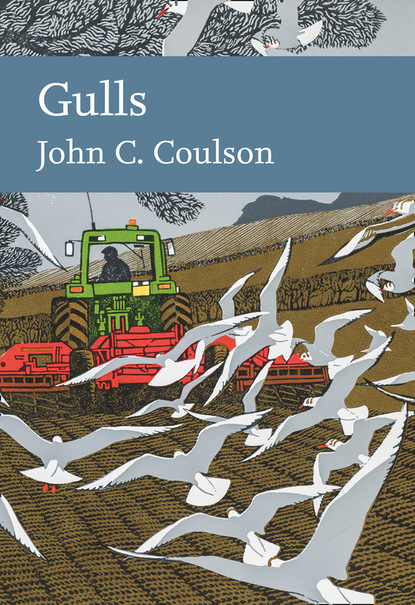
Полная версия:
Gulls
While nests of most gulls are formed by an accumulation of plant material, the exception is the Kittiwake. The adults collect marine algae and mud to form a base for the nest, and as this dries, it becomes firmly cemented to the rock surface, forming a base on which the rest of the nest is then built. The nest is completed by bringing in grass to form the top. This species is exceptional in that the adults at the nest defecate onto and over the edge of the structure, leaving obvious white streaks on both the nest and the cliff face below, and thus clearly make no effort to disguise the nest. Other gull species move away from the nest to defecate. The Kittiwake also differs from other gulls in that nest-building is often highly social, with a hundred or more individuals repeatedly flying back and forth between a particular source of mud and vegetation and the nest sites. On one occasion when in spring a local farmer spread straw and dung onto a cliff-top field, within a week the nearby Kittiwake colony was entirely draped with long strands of golden straw.
Recently fledged young and immature one- and two-year-old Kittiwakes often pick up potential nest material from the tideline and fly about with it in their beaks, but eventually drop it without taking it into a colony. I have not seen immature individuals of other gull species doing this. Non-breeding three-year-old Kittiwakes often occupy sites in a colony and bring in small quantities of nesting material very late in the breeding season, when most pairs of Kittiwakes have half- or full-grown chicks. In some cases, this forms a base for a nest in the following year. The chicks of most gulls leave the nest when a few days old, seeking cover and protection, but the Kittiwake is again exceptional in that the chicks remain on the nest until they fledge five or more weeks after hatching.
Depending on the position of the colony, some Kittiwake nests are washed off in winter storms. However, those in more sheltered positions remain over winter and until the following breeding season when they are used as the base of new nests. One nest on the Farne Islands was supported in a vertical cleft in the rock face, and as material accumulated year after year, it reached a height of more than 100 cm.
Eggs
All gull eggs have a brown or grey background with numerous spots or streaks of darker pigment, offering a degree of camouflage if they are left uncovered in the nest. The extent to which camouflage prevents or reduces predation of gull eggs has not been investigated, but it can only be one of several factors affecting successful breeding.
The size of egg laid by gulls varies with the average weight of each species, but not in a simple linear manner (Fig. 10). At one extreme, the Little Gull lays an egg that, on average, weighs 18.6 per cent of the normal body weight of females, while the egg of the largest species, the Great Black-backed Gull, weighs only 7.3 per cent of the female’s body weight. The change in egg size as a proportion of the adult weight is a common effect in many bird groups and not just a peculiarity of gulls. Large eggs, irrespective of the species laying them, usually require a longer incubation period, although the reason for this is not immediately obvious. Presumably the body of a chick of a large gull species has more cells and requires more cell divisions before it is ready to hatch. However, that is not the only factor involved, since the eggs of birds in some other taxa, such as the Procellariiformes (petrels and shearwaters), require a much longer incubation period even when the eggs are of the same size.
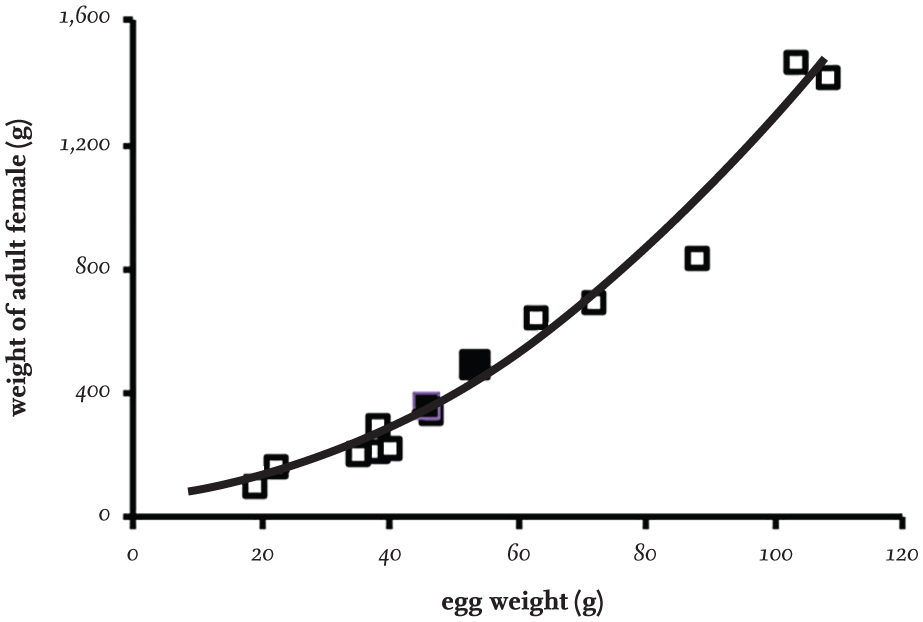
FIG 10. The relationship between the average weight of adult females of 13 gull species and the average weight of the eggs they lay. The gull species that normally lay two rather than three eggs (Kittiwake, Rissa tridactyla, indicated by the lower of the two filled squares; and the Ivory Gull, Pagophila eburnea, indicated by the upper filled square) sit exactly on the curve calculated for the other species, which normally lay three-egg clutches, indicating that despite having smaller clutches they do not lay bigger eggs.
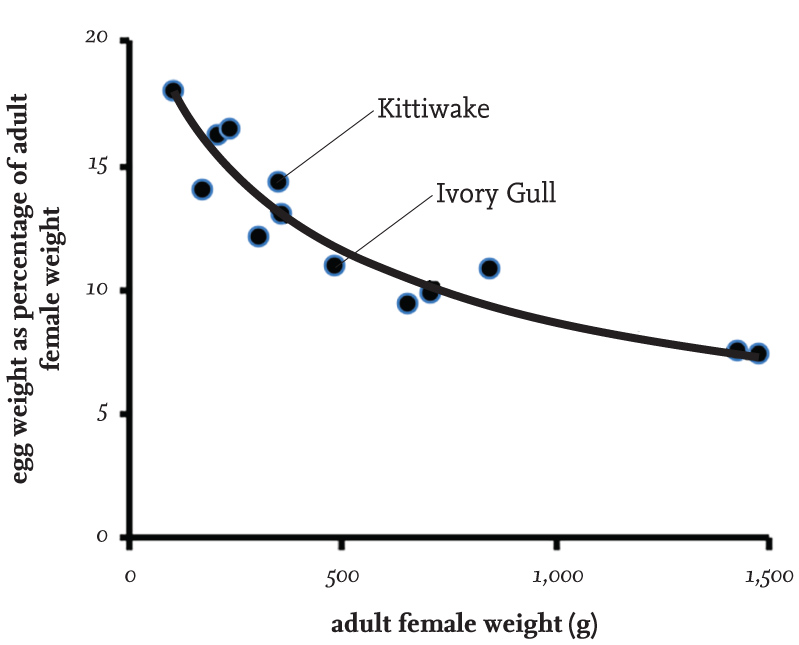
FIG 11. The relationship between the average weight of adult females of 13 gull species on the British list and the average weight of one of their eggs, expressed as a percentage of the female’s weight.
While the most frequent clutch size in gulls is three eggs, two species that occur in Britain typically lay two-egg clutches, namely the Kittiwake and Ivory Gull. This raises the question as to whether they respond by laying larger eggs. At first inspection, Kittiwake eggs look large, but this is an apparent effect of their paler background in comparison to the eggs of most other gulls (see here). Fig. 11 shows the relationship between female weight and egg weight for a series of species. The relationship is curvilinear, but the Ivory Gull and Kittiwake sit almost exactly on the curve, fitting the data based on the other gull species.
Each egg is laid at about two-day intervals. Usually, the last egg in the clutch is the smallest and tends to differ in shape, being longer and narrower than the rest. The infrequent cases of four eggs in a clutch are probably the result of a second female contributing one or more eggs. This can occur when female–female pairs are formed, caused by a shortage of males. Incubation lasts for more than three weeks and is longer in the larger species. Both members of the pair contribute to the incubation and feeding of the young.
Incubation period
Ideally, the precise measure of the incubation period is the length of time that the eggs are maintained at a temperature just below the adult’s body temperature of about 40 °C. There is a lower temperature (which may be as high as 25 °C) below which the development of the embryo ceases; in temperate regions, this is usually above the environmental temperature. As a result, development soon stops when the eggs are not covered by an adult and the temperature falls below the critical temperature for development. If the incubation of the eggs is frequently interrupted, the time taken for the eggs to complete development to hatching is lengthened.
In practical terms, the incubation period is usually measured as the number of days taken from the start of incubation to the time the egg hatches, but hatching takes several hours and confusion has existed as to whether the end of incubation is when the shell is first pierced by the chick or when it becomes entirely free of the shell. Covering the eggs by an adult gull often takes place before the final egg of the clutch is laid, but in some cases the vascularisation of the brood patches on the adult may not have become fully developed with supplementary blood vessels and the optimal temperature for embryo development may not be reached. Consequently, there may be a delay of a day or so until the eggs reach the critical temperature for development. As a result, the recorded incubation period for a species will vary. The incubation period of birds, and in gulls in particular, is slightly longer in the larger species, but the differences are small and the variation recorded between individual pairs is considerable (Table 6).
In gulls, the incubation of the eggs is often initiated by the female, but overall the sexes tend to share incubation equally in a shift system. Either sex may incubate overnight. In most cases, the incubating individual remains on the eggs until relieved by its partner, so that once incubation starts, the eggs are covered by an adult for about 90–95 per cent of the time.
TABLE 6. Estimates of the incubation period in eight well-studied gull species, presented in order of adult size (smallest first). Data mainly from Cramp & Simmons (1983), Fisher & Lockley (1954) and other sources where appropriate, including personal data for the Black-legged Kittiwake.
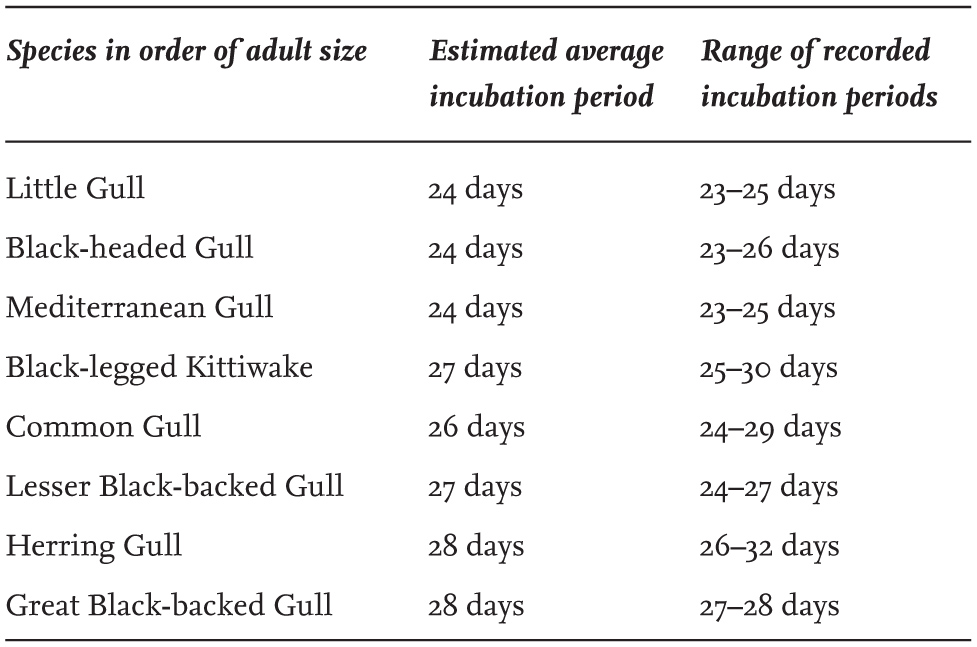
Periodically – perhaps five to eight times a day – the incubating adult will stand up and roll the eggs. Egg-turning is believed to facilitate the absorption of the albumen by the embryo and prevents the embryo from adhering to the shell membrane. In domestic hens, the failure to roll eggs in an incubator does not necessarily prevent chicks from hatching, although the success rate is reduced and the chicks often have a lower weight. Egg-turning is unique to birds and the reason why reptile eggs do not need to be rolled is as yet unclear.
In gulls that lay three-egg clutches, it is common for the third egg – which is laid two or three days later than the second egg – to hatch one or sometimes two days after the first two. This asynchronous hatching suggests that effective incubation in these cases starts during the normal two-day period between the laying of the second and third eggs.
Chicks
At hatching, chicks of most gull species have a patterned down that offers some cryptic protection; this is replaced by a pattern of dark feathers that helps to conceal the young birds when they attempt to hide under vegetation. The dark patterning at hatching is missing in Kittiwake chicks, which hatch with a pale grey down and then acquire white, grey and black feathering when older, all of which could also be regarded as aiding camouflage among the whitewashed nests and rocks on the cliffs where they nest.
An effect of the relationship between egg size and adult weight is that, at hatching, the chicks of larger gulls are smaller in proportion to the adults than those of small gull species, and they therefore must achieve more growth in order to reach their adult size and weight. This is presumably one of several reasons why the period of chick growth (and the fledging period) tends to be longer in large gull species than in small ones.
The time between the chick hatching and first flying is known as the fledging period and also shows much individual variation (Table 7). There is a weak trend for it to be longer in the larger species of gulls. The fledging period of the Kittiwake tends to be longer than in other gulls of a similar size. In the case of the Kittiwake, the first flight has to be totally successful from the cliff-nesting site and so is an all-or-nothing event, with the young bird either flying well enough to reach and return to the nest, or to achieve sustained flight immediately, leave the colony and start an independent life.
Fledging is often a gradual process and tends to take longer in the larger species. It is longer in Kittiwakes, where the young cannot fly until they are at least five weeks old and many are at least a week older before their first flight. Unlike most terns, parental feeding of young gulls often ceases at the time of fledging, but sometimes family parties of large gulls stay together for some weeks. During this time they visit feeding sites together and make loud contact calls while moving between areas, and they may even return to the colony in the evening. Exceptionally, a Herring Gull has been observed feeding chicks three months after they fledged.
TABLE 7. Estimates of the fledging period in eight well-studied gull species, presented in order of adult size (smallest first). Data mainly taken from Cramp & Simmons (1983), Fisher & Lockley (1954) and modified from other sources where appropriate. Note that the considerable variation in several species is genuine, and depends on the rate of growth and development of the chicks and whether there had been a stimulus to fly, for example, by the presence of a predator or the observer.
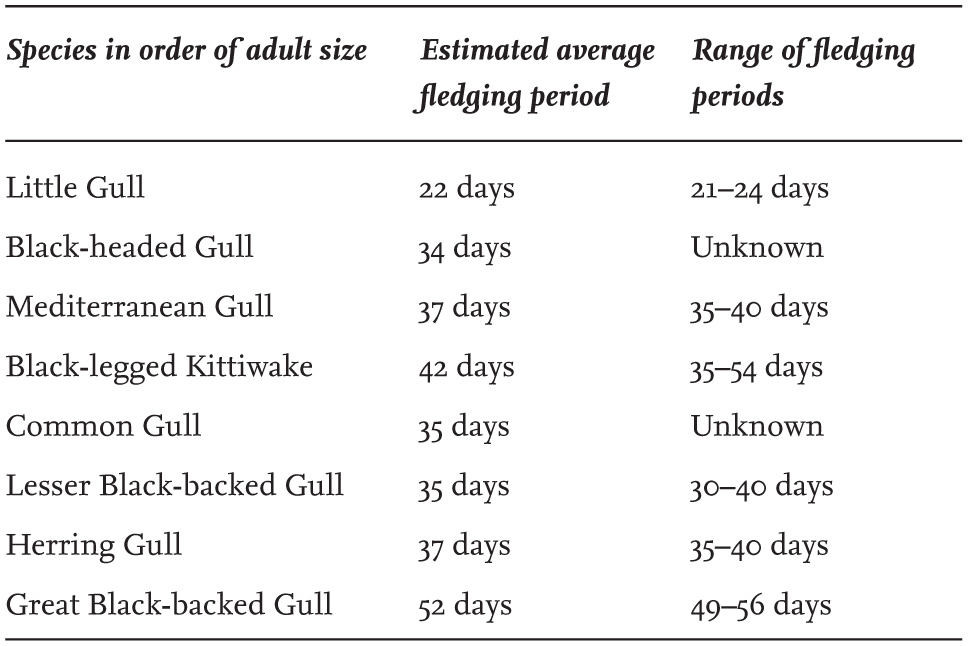
Breeding success
Under favourable conditions, breeding success of gulls is high, with about half the eggs laid producing young that fledged. However, lower success rates occur when there are food shortages or predation occurs. No gulls are known to breed as one-year-olds and they do so only when they have acquired almost adult plumage.
WALKING AND FLYING
Gulls have relatively short legs, and this is particularly true of Kittiwakes and Ivory Gulls. Gulls typically walk or run only short distances, and rapid movement beyond a few metres is usually achieved by flying. The exception to this occurs when gulls are searching for food on grassland and mudflats, when walking – with stops to pick up food – is the norm. Of all gull species, Kittiwakes walk less than any other. During an appreciable part of the year they are oceanic, either flying over or floating on the sea. Immature Kittiwakes that visit land during moult typically remain where they alight, and the adults fly directly onto their nests on precipitous sea cliffs without needing to take more than a step or two as they land. This behaviour is associated with the species having short legs (an adaptation to produce a low centre of gravity to enable the birds to withstand strong gusts of wind while nesting on sea cliffs), while the Kittiwake’s hind toe, which in other birds – including gulls – assists with walking, is reduced to a small protrusion.
The long, narrow wings of gulls, petrels, albatrosses and shearwaters are an adaptation for flight over water, particularly where the sea surface has peaks and troughs that affect wind movement. Many gulls fly with steady wing-beats, while at other times they introduce periods of gliding, between wing-beats. They utilise rising air currents, particularly those over the sea produced by waves or swell, although it is rare for them to fly more than a few metres above the surface of the open sea. In addition, they glide in thermals over land and cliffs, and those produced by buildings in urban areas. Several species of gulls use thermals to rise to considerable heights over land without the need for flapping flight, although the smaller species more rarely soar. Favourable conditions for soaring occur on warm, sunny days. Such apparent effortless flight can be seen in Herring Gulls that breed on the coast but visit the highest ground on Snowdon in north Wales, where they search for food discarded by people walking and climbing here.
MOVEMENTS
Gulls breeding in extreme northern and southern areas of the world are migratory, but this is usually less pronounced or even absent among those living in temperate or equatorial regions. In general, the distances gulls migrate are much shorter than those made by terns, with only Sabine’s and Franklin’s gulls making regular large trans-equatorial migrations. In other gull species, a few individuals may reach or cross the equator, but most remain in the hemisphere in which they breed or were reared. Whether gulls migrate mainly depends on whether food is readily available in winter in their breeding areas.
The seasonal movements of many gulls are better described as dispersal rather than migration, with individuals from the same area or even a single colony moving in different directions and for variable yet often short distances. Immature individuals tend to move further than adults and often do not visit their natal or other colonies where they will ultimately breed for several years.
MOULTING
In all gulls, the 11 primary feathers on the wing are moulted in sequence, with the inner primary being replaced first. The remaining primaries are then progressively replaced outward towards the longest, the 10th, and then finally the small 11th primary on the bastard wing (Fig. 13). With the exception of one species, the flight and tail feathers are moulted and replaced once a year, but some of the body feathers are moulted twice each year.
The exception to this is Franklin’s Gull, which moults all its feathers – including the primaries – twice a year, and as a result adults are missing primaries somewhere in their wing for about two-thirds of the year. This is a surprising pattern, because the efficiency of flight is affected by the loss of some of the primary feathers, particularly the longer outer ones. Most adults will have just completed the post-breeding moult when they start the next primary moult in December, which continues for several months. The information on moult in Franklin’s Gull is based on a small number of specimens and requires further investigation, but the available evidence suggests that the post-breeding primary moult is spread over four months and the pre-breeding moult over a slightly shorter period. Carrying out two primary moults in a year is energetically and nutritionally costly, and no convincing explanation has been offered for it. It could be that exposure to more intense sunlight throughout the year (Franklin’s Gulls winter south of the equator) causes the structure of the primary feathers to deteriorate quicker. However, this is not a convincing explanation, because other gull (and tern) species living in similar areas and making migrations across the equator appear to manage with a single annual primary moult (see also here).
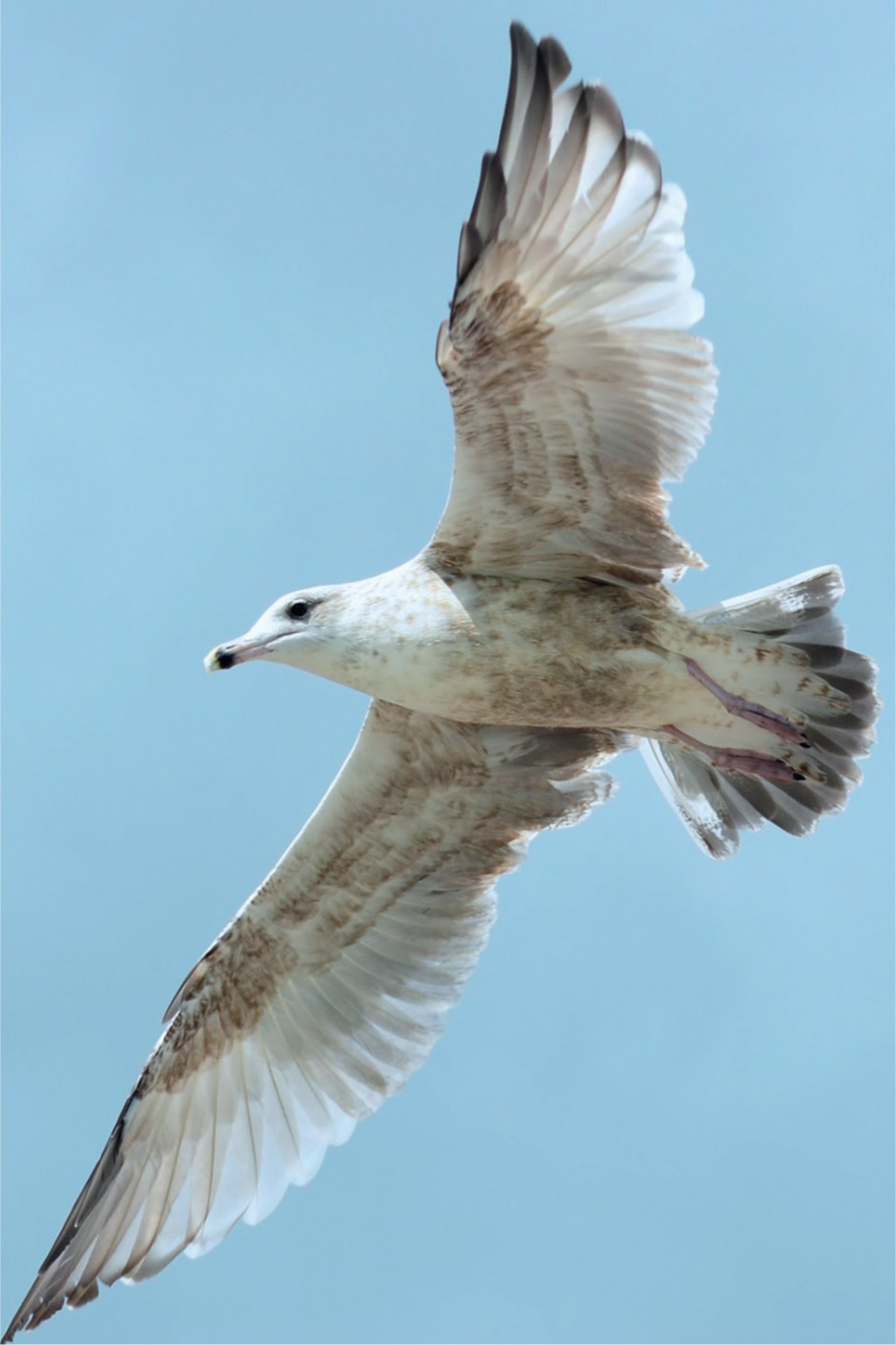
FIG 12. Herring Gull (Larus argentatus) presumably starting its third year of life, still lacking white mirrors and with the new outer primaries and the outer tail feathers still growing. (Mike Osborne)
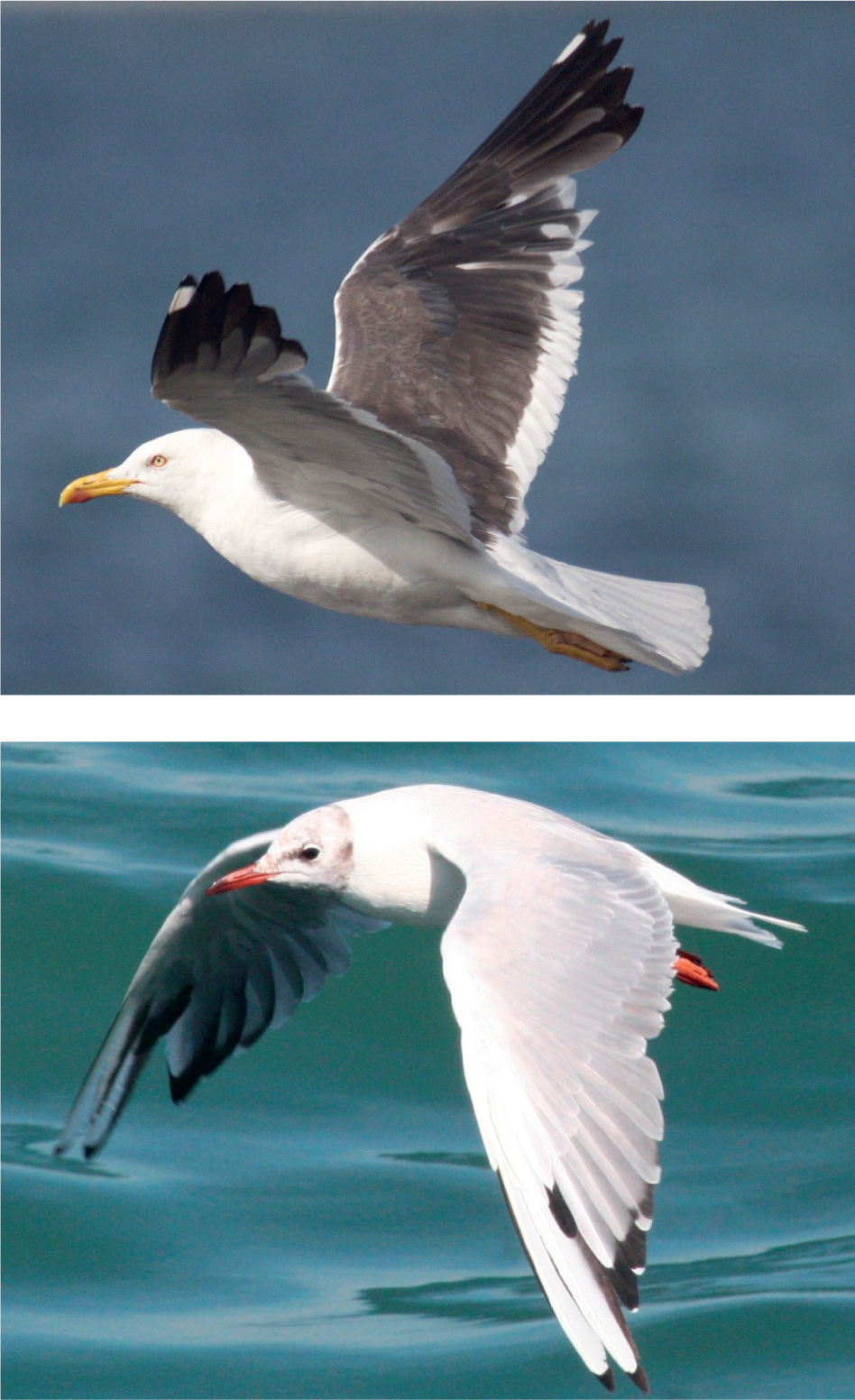
FIG 13. Above: adult Lesser Black-backed Gull (Larus fuscus) in primary wing moult, with only five of the longest primaries remaining to be moulted and several new, inner primaries in growth. Below: adult Black-headed Gull (Chroicocephalus ridibundus) in primary moult, with the two longest primaries (P9 and P10) not yet dropped and replaced, P8 missing and P7 half-grown. (Nicholas Aebischer)
FOOD AND FEEDING
Gulls are usually classified as omnivores and scavengers, and animal material greatly dominates the diets of all species. The spectrum of food sources taken by gulls is much wider than in terns. Fish and invertebrates are the main food of many species, and small mammals are also taken by the large species. In addition, the larger gulls are often predators on eggs, chicks and even adults of other birds, and several consume eggs and chicks of their own species, although they usually avoid killing their own broods.
Typically, gulls obtain their food from the ground or near the surface of water. Most species can plunge from flight into water in an attempt to capture live food organisms within the top metre or so, but they lack the penetrating diving thrust of Northern Gannets (Morus bassanus) and some terns. Small gulls often pick food items from the water’s surface, either while in flight or phalarope-like when floating on the surface. Gulls breeding inland feed on insects emerging from freshwater bodies and from flat terrestrial areas, and some even catch flying insects such as swarming ants and mayflies.
No gull species regularly and predominantly feeds on vegetable material, although some take berries and grain – for example, Herring and Lesser Black-backed gulls regularly search for animal feed on farmland and also consume grain in the spring and autumn. In some arctic areas, berries have been reported as a component of the diet of gulls, but this source of food is uncommon in more southern areas. That said, there are reports of berries being plucked off Hawthorn (Crataegus monogyna) bushes and even acorns still on oak trees being consumed by Black-headed Gulls. Many stomach analyses of gulls report small quantities of plant material, but these could have been accidentally ingested when picking up animal prey from the ground or even originate from the guts of the animals the gulls consumed. Many gulls will eat bread and other vegetable matter when offered it or when it is discarded by humans, and they often compete for food offered to waterfowl. The late Max Nicholson, who wrote Birds and Men (New Naturalist 17, 1951), was one of many who frequently and regularly fed gulls in winter at lakes, in parks and on the riverside embankment in London in the first half of the twentieth century.
In the last century or so, several species of gull have started to utilise waste materials dumped by humans and they also follow behind tractors during the ploughing of agricultural land. Availability of foods associated with human habitation has attracted gulls to places such as landfill sites and fishing boats, particularly when nets are being hauled in or fish are being gutted at sea. In many areas across Britain, such sites have become a major food source for several species and have played a role in the growth of gull populations. As a consequence, some species are now considered pests and their numbers are managed. As refuse is increasingly being managed in ways that gulls can no longer exploit, and landfill sites previously used by gulls are being closed, this is likely to have an effect on the size of gull populations. Evidence of the magnitude of such changes is yet to be clearly identified, however, and the extent to which gulls can change their feeding habits and find new food sources remains unknown.
Scavenging on carrion or stealing food from other birds (kleptoparasitism) are other commonly employed methods of obtaining food. Kleptoparasitism in gulls is sometimes directed towards their own species and seems more frequent among male gulls. Smaller species of gulls join flock of Lapwings (Vanellus vanellus) and Golden Plover (Pluvialis apricaria), and steal prey items captured by the plovers, particularly when these are too large for them to swallow immediately. Sea ducks, particularly Eiders (Somateria mollissima), are attacked by large gulls when they surface with prey items in their bill, such as crabs, that need to be handled and processed before they can be swallowed. Indigestible items that are eaten by gulls as part of their diet are regurgitated as pellets, and offer a method of identifying some of the food consumed.
DRINKING
All animals need to replace fluid in their bodies; while some obtain sufficient water in their food, others will travel some distance to obtain it. Those species that spend long periods of time at sea or nest on small islands without available fresh water have no option but to drink seawater, although this causes physiological problems owing to its appreciable salt content.
A sailor crossing a large expanse of ocean in a small boat can use a solar still to produce drinking water, and gulls (and many other birds) have the equivalent of this in the form of nasal glands, which are situated between the eyes. When they drink seawater, gulls use these glands to excrete a saline solution that has twice the concentration of the seawater, and by doing so reduce the concentration of salt in their bodies. Not infrequently, gulls are seen with water dripping from the end of their bill. These drops do not necessarily indicate that the bird has recently dipped its beak into water, but are the hypertonic saline solution excreted from the nasal glands. Using this method to remove excess salt from the body involves an energy cost for the birds, so it is not surprising that gulls show a strong preference for accessing and drinking fresh water wherever possible and are frequently seen congregating at freshwater pools and lakes. Herring Gulls at some urban sites even use small pools of fresh water when larger freshwater bodies are not available (Fig. 14). While Kittiwakes depend entirely on seawater and the healthy functioning of their nasal glands in their pelagic wintering areas, in the breeding season some will fly up to 2 km inland from their colonies to drink and bathe in fresh water. Those gulls that breed in colonies where no fresh water is locally available must depend on their nasal glands throughout the year.
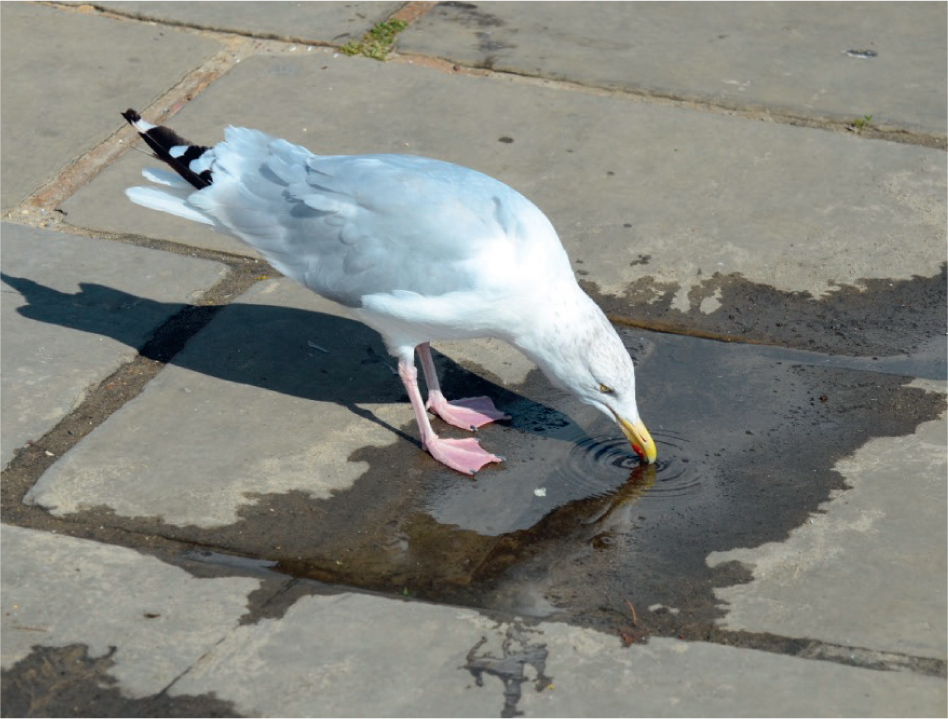
FIG 14. Urban Herring Gull (Larus argentatus) attracted to drink at a small source of fresh water. (Mike Osborne)



